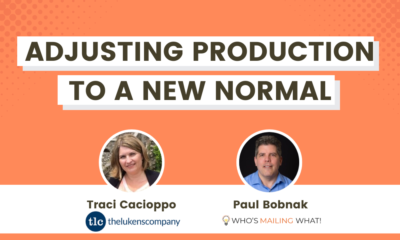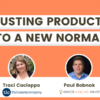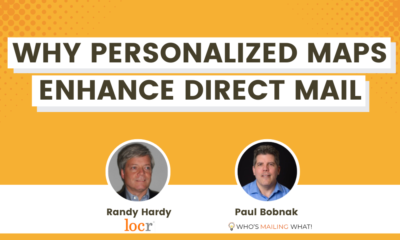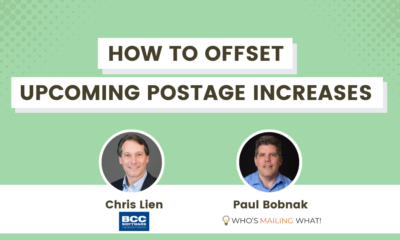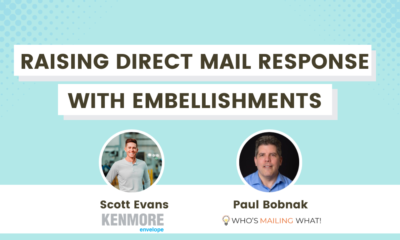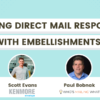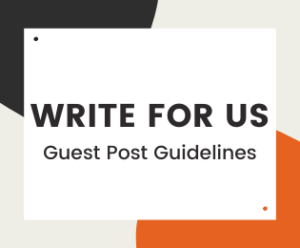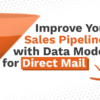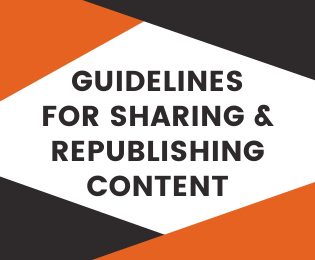MEET THE MAILERS
Meet the Mailers: Being a Problem Solver
In this episode, we talked with Production Solutions about how the company is revising its missions to emphasize solving problems for its clients and partners.
In this episode, I talked with Benjamin Harris, President of Production Solutions, a Moore Company serving the nonprofit community. Based in Vienna, VA, Production Solutions offers a suite of marketing services including channel-specific specialties in direct mail, digital marketing, DRTV, caging and donation processing, video production and more.
We talked at length about the recent challenges facing the company’s clients, such as ideas, cost reductions, support, and more.
Ben described his company’s shift in focus towards emphasizing solutions for clients and partners:
We feel one of our kind of revised missions, if you will, is the world needs trusted problem solvers.
 Ben Harris
Ben Harris
President
Production Solutions
Among the many topics we covered:
- Ben’s 20+year industry background
- Prioritizing leadership of all kinds, including DEI initiatives
- Challenges facing mailers today
- Trends in direct mail and the role of AI
- Why direct mail works
- A recent mail piece that inspired him to act
Here are some questions and answers from our conversation (edited for clarity and space):
- One of the challenges in our larger field of nonprofits and fundraising is talent – both attracting new people as well as keeping current staff growing and engaged through support and keeping their skills relevant. Why is this so important to you as a leader, and what kinds of things are you doing to have that kind of a company culture?
That’s a great question. I think it needs to be a priority. And you really need to look at it as a sort of an endeavor, something that really never ends. And especially in my time at Production Solutions now spanning two-plus decades. Seeing the company through the pandemic and just all kinds of other changes in the industry and the world, people have an urge and a desire to grow and take on new challenges. And I think just making sure that that’s a priority and growing other leaders.
So from that perspective when you prioritize leadership – and what we say at PS is everyone is a leader, everyone can lead. We’re better when everyone does lead. I fundamentally believe that human beings have an affinity to lead and leadership can look very different outside of the formal leadership roles which someone like myself has. But there’s a lot of – and I would say daily – informal leadership opportunities that you need to identify, encourage people to lean into, and it then becomes more of a practice and a discipline of when everyone leads, we can be better and that’s what we continuously try to do and invest in as a business.
- Let’s talk about one of those investments, which is DEI initiatives. Can you talk about that and if you think that there are learnings that can be applied to the fundraising and nonprofit community in general?
It’s important to have a plan that is guided by metrics, a vision statement, a mission statement, initiatives, and in something again, that sort of becomes endeavor-like in terms of it not a one-and-done. It requires ongoing learning, some trial and error.
One of the things that we felt was important for our company to continue is to make sure that number one, we have a good sense of psychological safety within the organization, that people show up to work and that they know that the company and their colleagues have their back and are going to encourage them to do more of those leadership initiatives or take some leadership steps forward. And you can only do that when you feel like you can be yourself and you know others around you are being encouraged to bring their best self to work. And that was sort of the foundation for us is how do we help our people be better at who they are and what they can do, because when they show up and are their best selves, it translates to a great customer experience.
In addition to that, we felt like having a diverse array of suppliers in terms of how we go about sharing the work that we do and learning from them. So we started to measure some different DEI metrics in the supplier community and talk about things that they’re learning, things that they can continue to help us learn and make sure that we’re moving diversity of thought and also this this commitment to inclusivity together with our partners, while also being responsive to what our clients need and what they are doing with their own DEI initiatives. So I think having alignment between your own business, what the clients need and expect and also what’s going on with your supplier partners or agency partners helps it be what I would call more of a fluid ecosystem and kind of overall experience.
- You know that word “production” in the company name is pretty significant because of all the challenges that direct mail programs are facing. How can Production Solutions help non-profits deal with them?
So one of the shifts for us as recent as this year as we started to look at our vision, mission, and values and where do we where do we need to go from here based on what’s happening in our clients’ business and the industry at large and we we sort of homed in on the word “solutions” instead of production. We feel one of our kind of revised missions, if you will, is the world needs trusted problem-solvers, and that word “trust” is really key in that statement and sort of leans into that word “solutions”.
From talking to many of our clients and agency partners at the end of last year and even continuing this year, they’re looking for new ideas …any type of innovations that can help them in their businesses. They’re looking for budgeting accurately and reducing costs. They’re looking for the service experience to be accurate, easy and consistent. [W]here they spend their time has become even more crowded. They’re looking for omnichannel support and integration, and the other one is to help them with any type of technology or sustainability efforts that are at play as well. So those are the five themes that I would say you could talk to any fundraiser today and they would say, “yeah, those are those are our challenges as well”, and how can we show up and be a problem solver with those challenges in mind, because some of them are based in production or print and mail, but some of them are starting to kind of expand beyond just print and mail from that standpoint.
[W]hen we talk to our employees about some of the challenges that our clients are facing, I would say just in general, since late 2019… on average our clients’ costs are up anywhere from 40 to 80% in less than a three-year period. So a lot of that is postage and I think the post office …you know there’s almost two sides of it, right? There’s this sort of runaway cost increase side, but it’s also important to not demonize them too much because they’re super important to direct mail fundraising, right? So we tend to focus on all the negative, but there is a lot of good that is there as well in terms of some of the postal promotions and some other things that if you can leverage those as well, it can help offset some of the costs.I think there’s a limit in terms of what we can do within our business, primarily focusing on direct mail and how we can help clients integrate from an omnichannel perspective. We’ve done a lot of Informed Delivery management for clients. We’ve helped them take advantage of some of the USPS promotions, the tactile, sensory and interactive, and then also the emerging and advanced technology promotion. In 2023, we saved clients over $1.5 million, leveraging the Informed Delivery promotion… up 27% from 2022. So just a sign that shows you that clients are more apt and willing to have a digital integration with their mail piece, and that’s just a small digital integration, as you know.
But those are some of the things that I think if you’re in print or in direct mail only, you can be leading with those. In addition to making sure that from a production standpoint or a quality control standpoint, if a client has a URL on there or QR code, that you’re checking those for accuracy, that they’re actually going to a live website or landing page. You know that can be problematic if you’re printing that and sending it out and you’re trying to drive clients to some landing page and it’s not working, you can, you know, flag the client on those types of things.
But I think one of the more interesting sort of points that I’ve heard from some of the industry colleagues and the agency partners we work with is that direct mail has become more of a channel of influence. Kind of all boats rise in the tide. [I]f you cut back on direct mail – while it may save you money initially – the influence that it has on all the other channels today will be sort of stunted.
So which kind of leads into the attribution of where does this donor, where does this gift come from? [M]aybe AI will help solve some of this, but just continuing to be able to identify … we sent a direct mail piece. We did a landing page. We did a digital ad and Paul or Ben respond, where did they actually come from … did something influence them, because it may not be that the gift came through on direct mail. This may have come through on the landing page, but the direct mail piece sort of brought more attention to the digital ad, if you will, because the timing was done.
- In your career, what would you say is your most memorable moment or accomplishment so far?
That’s a great question. I would say, you know, probably from a maybe twofold or a two-part answer. I worked on, as a production manager, some of the new museums, new at the time. For example the National Museum of American Indian being a part of that program from the early days of raising funds and the capital campaign phase all the way through breaking ground and the museum being open to the first year of new membership and all of that. [T]hat typically takes a good ten years from start to finish and we’ve serviced and been a part of some of the groundbreaking museums and we’ll hopefully be doing some more of those in the future.
And then I’d say personally, taking over for the founder of Production Solutions and not really having a sort of any experience in being a president of a company and having to figure some of that out and do it in a way that would maintain the legacy of what made PS great, but also try to bring some new things to help it continue to stay alive and and go well into the future is the second one that I would say is so far I’m most proud of.
- So what trends do you see for direct mail marketing? And do you see a bigger role – you touched on this briefly – for AI in both production and creative?
Yeah, I actually had a little fun with this question since I had a chance to to preview these with you a little bit in advance. So I used AI to ask the question and it says here you know I said “What role will AI play in the trends that … of the next 12 to 18 months?” so, and you know many of these [answers] are similar.
So, enhanced personalization, optimize targeting, predictive analytics, campaign automation, creative design assistance, real time tracking and optimization, response rate improvement, integration with digital channels, customer journey mapping, voice technology integration, enhanced data security and feedback, and continuous learning.
Sort of the way I would summarize that and the answer made sense to me basically is that if we can make direct mail function almost like a digital channel. Our CEO of Moore, Gretchen Littlefield, talks a lot about mail is now digital, leveraging data and all the data assets that you can that are individualized and using digital printing and some of the advancements there to make the direct mail piece so much more 1-to-1 or personalized, without increasing costs like it would have been 10 years ago.
So leveraging data – as you leverage data, having really good data security and data governance from that perspective and then, trying to tie in all of the creative assets and all the omnichannel integration at a speed that is almost hard to grasp …if you can do that, I think those are some of the things that will hopefully allow mailers to mail less because that’s happening with increased costs and so on. But make the mail pieces so much more valuable than they are today. Keeping that channel of influence in mind and seeing if it can be continued to influence the other channels even more effectively than it does right now.
- What would you say is the best value proposition for direct mail? You know, you’ve talked about, you know, it being a channel of influence… and why it works today.
Well, I think it’s still, you know from all the research and the data that I’ve seen and been a part of over the years … there’s something about direct mail that I think is unique in terms of the tactile, sensory and sort of the novelty of going to the mailbox every day and not knowing what you’re going to get that triggers some of the psychological sort of factors inside human beings, that there’s just something kind of new and nuanced about it that kind of brings you a thrill and excitement. [T]here’s less noise there in mailboxes today than there is in digital channels that’s becoming sort of dizzying for a lot of recipients, whereas direct mail you can take it if you want to make the time to look at it. It may not mean that’s how you donate, but that sort of connective tissue or that influence to the other channels of how you might give online or so on, it’s measurable.
I think you can talk about attribution; like if you send something out and someone responds to a direct mail piece, you can really measure it. And it’s it’s something that I think you can for the most part – this has started to change a little bit planned for in terms of what it’s going to cost 6 months from now or 12 months from now, even three years from now, that’s been a little bit turned inside out with the pandemic and what’s going on with the post office. But it’s more of this reliable … long-standing kind of workhorse that has really sort of driven fundraising for so long that I think it’s just … it’s still an important part of the overall sort of product mix, if you will, or program mix that I said and we talked about some of the things that are challenging that, but hopefully emerging technology and some advancements in the manufacturing spaces will allow for direct mail to not have to go by the wayside, primarily just because of cost. And that’s been its biggest challenge right now since the pandemic is the cost factor not so much the effectiveness of it not working factor.
- One quick last question: what was the last mail piece or maybe a good recent one that you responded to and what was it that made you do that?
Well, I might be biased with this answer, but we have a client [Heifer International] that does a holiday gift catalog where you can buy goats and honey bees and donate to a village and those types of things. And they’ve been doing that for at least 30 years and I just think it’s really an amazing piece … It reminds me a lot of memories of getting the gift catalog when I was a kid and flipping through that around the holidays and looking at the toys. [T]here’s just a lot of nostalgia around it and again it’s very unique and I still receive and have donated and now brought our kids in and they look for it.
- And through it all, it still works.
It does! Yeah.They’ve had to make some adjustments with size and rising postage costs and all that, but they continue to stay committed to it because it does bring people back and their donors do look for it every year, that time of year, because it’s become such a brand. You know – such an affinity to the brand and their mission that it’s hard to move away from it.
Here is our conversation (with all questions and answers). We’ve added timecodes for your convenience.
Thank you very much, Ben, for sharing your perspective and your expertise! To learn more about Production Solutions, visit their website at ProductionSolutions.com.
Your comments and ideas are very important to us in making your Who’s Mailing What! experience even better for you. Through these engaging talks, we hope you’ll take away practical tips, insights, and personal stories to inspire and build your own success.
If you have any feedback — or are interested in sharing your story and viewpoint with our wide and diverse audience on “Meet the Mailers” — please reach out to me. I’d love to hear from you!







